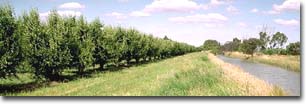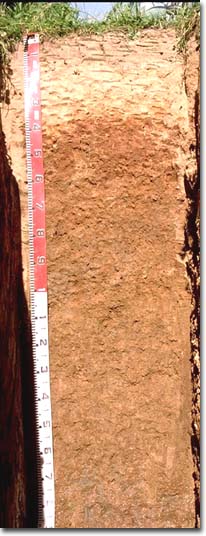GN25
| Location: East Shepparton Landcare Group. | Australian Soil Classification: Bleached-Sodic, Calcic, Red CHROMOSOL. |
| Northcote Factual Key: Dy 3.42 | Great Soil Group: red-brown earth |
| General Landscape Description: Level plain with prior stream activity. Pears are currently grown at this site. This site has been mapped as Orrvale Loam by Skene and Freedman (1944). | |
 Site GN25 Landscape |
Soil Profile Morphology:
Surface Soil
| A1 | 0-13cm | Brown (10YR4/3) fine sandy loam; weakly structured; very firm consistence dry; contains a trace (< 2%) amount of quartz gravel (2-5 mm size); pH 5.7; sharp change to: |  Site GN25 Profile |
| A2 | 13-30cm | Strong brown (7.5YR5/6), conspicuously bleached (5YR7/4d) fine sandy loam; structureless; very firm to strong consistence dry; contains very few (< 2%) quartz gravels (2-5 mm size); pH 6.1; clear and wavy change to: | |
| A3 | 30-35cm | Yellowish red (5YR5/8) fine sandy loam; structureless; strong consistence dry; pH 6.3 clear and wavy change to: | |
| Subsoil | |||
| B21 | 35-55cm | Yellowish red (5YR5/8) with pale brown (10YR6/3) slightly mottled medium heavy clay; moderate coarse blocky structure; very strong consistence dry; contains very few (1-2 %) soft carbonates (<2 mm size); pH 7.3; clear change to: | |
| B22 | 55-75cm | Yellowish red (5YR5/8) with pale brown (10YR6/3) mottled medium heavy clay; moderate coarse blocky structure; firm consistence moist; contains very few (2 %) soft carbonates (2 mm size); pH 7.4; abrupt change to: | |
| B23 | 75-90cm | Strong brown (7.5YR5/6) with brown (10YR5/3) and yellowish red (5YR5/6) mottles; medium clay; moderate coarse blocky, parting to moderate medium polyhedral structure; firm consistence moist; dark manganese stains common (10%); pH 7.8; abrupt change to: | |
| B31 | 90-100cm | Light brownish grey (10YR6/2) with yellowish red (5YR5/8) and strong brown (7.5YR5/6) mottles; light medium clay; strong medium polyhedral structure; firm consistence moist; contains a few (5-10%) dark manganese stains; pH 7.7; clear change to: | |
| B32 | 100-170cm | Yellowish brown (10YR5/4) with strong brown (7.5YR5/6) mottles; fine sandy clay loam; moderate medium polyhedral structure; weak consistence moist; contains a few (5%) dark manganese stains and some soft carbonate ('lime'); pH 8.8. | |
- Strong texture contrast between surface (A) horizons (< 15% clay) and subsoil (B21) horizon (53% clay).
pH | Salinity Rating | |||
Surface (A1 horizon) | slightly acid | very low | non-sodic | none |
Subsoil (B21 horizon) | slightly alkaline | low | non-sodic | none1 |
Deeper subsoil (at 1 m) | strongly alkaline | low | sodic | - |
Deeper subsoil (100-170 cm) | strongly alkaline | low | sodic | slight |
Management Considerations:
Whole Profile
- Plant available water capacity (PAWC) is potentially medium (estimated at 125 mm) for the top metre of soil at this site. This is based on available laboratory data and will probably be reduced due to the coarsely structured subsoil which will reduce effective rooting.
- Soluble salt levels are low throughout the profile.
Surface (A) Horizons
- The surface soil has a very high combined fine sand and silt content (79%). Organic matter is essential on such soils for maintaining aggregation and preventing slaking. Organic matter levels can be improved by minimising cultivation, incorporating organic materials and mulching.
Subsoil (B) Horizons
- Water movement from the surface horizons is likely to be retarded by the coarsely structured clayey subsoil. The subsoil is, however, largely non-sodic and has a calcium:magnesium ratio of less than one which should create reasonable subsoil conditions for root and water movement. The presence of conspicuously bleached horizons above the subsoil, and rusty root channel mottling in the surface soil indicates that some waterlogging occurs above the less permeable subsoil.
Comments from Landholder:
- Apricots can also be grown successfully on this soil.
Profile Described By: Mark Imhof, Paul Rampant, Sonia Thompson (1996).

